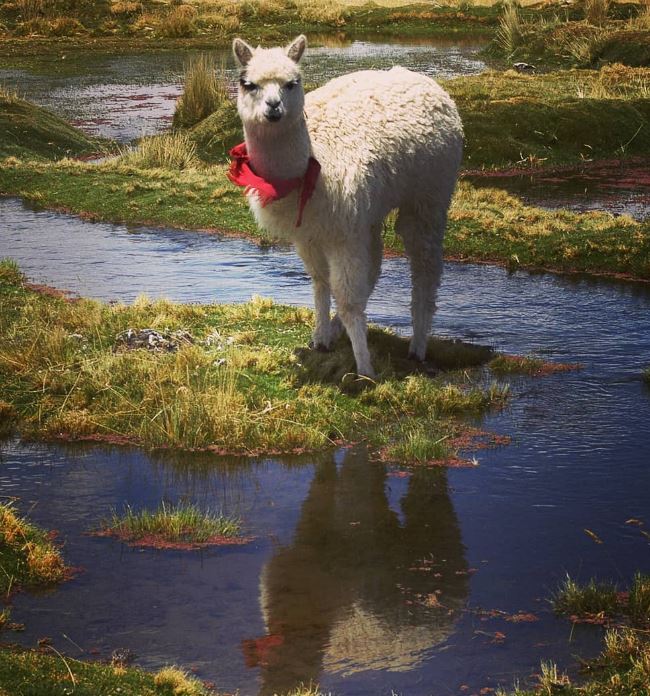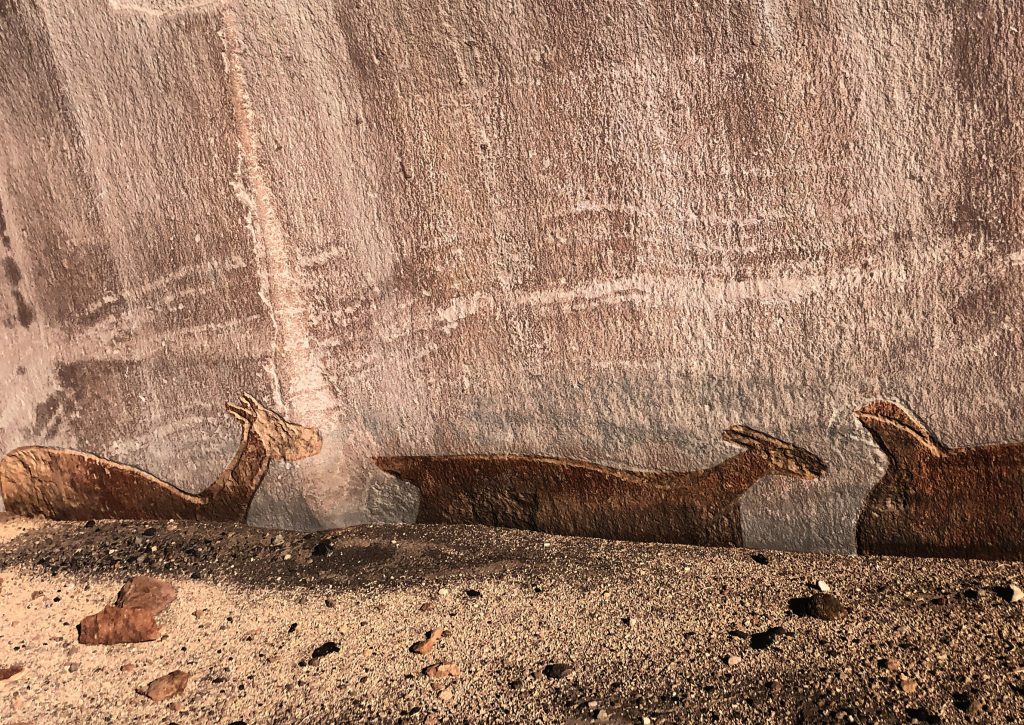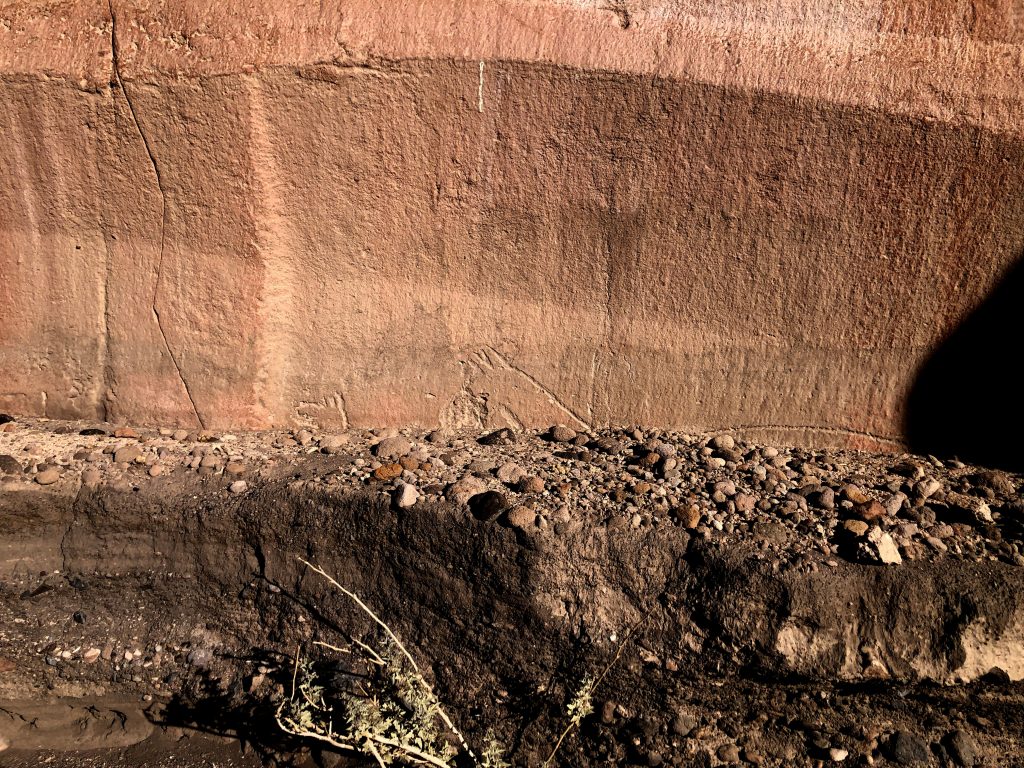Loss of cultural heritage in ancient Chilean highland valleys due to debris flows & floods
By Dana Bartelt & Francisco Martínez – The Future School 2024
This article contains reflections on part of The Future School’s Climate Change Advocacy 2023 Chilean Expedition study abroad program. It is published under the project “Media and Art Capture Climate Change” at UNESCO‘s global conference World Press Freedom Day
May 2-4, 2024 Santiago, Chile. The Future School partnered with UNESCO.
The Climate Change Advocacy program provides participants a broad perspective of the causes and effects of climate change by giving first hand experiences witnessing how people dealt with the consequences. They can then apply their knowledge to an advocacy project that suits their discipline or interests. Chile is a perfect ‘laboratory’ with its diverse environments from the glacial fields of Patagonia, the desert coastal towns,and the hottest altiplanic desert on the planet. Besides the melting glaciers and warming oceans, we discovered some lesser known effects of Climate Change.
Visiting the villages of Codpa, Cariquima and Talabre, towns of Parinacota, Tarapacá and Atacama -Chilean regions
Our first stop on our Altiplanic desert route was the village of Codpa, home to the Aymara people (Parinacota Region), located in the Camarones Ravine. We were met by Francisco Rivera Bustos, Aymara community representative and local promoter of cultural visits to the area. He took our group to a community park project on the edge of the village to join other volunteers planting native species. Afterwards he took our group to the nearby Ofragia preserve complex of petroglyphs (archeological panels) with over 400 figures.
Excerpt from Morgan Scarborough, 2023 participant from Appalachian State University, Communication major, podcast based on interview with Francisco Rivera:
“The dry desert climate of Codpa has preserved the history of Codpa. They find many artifacts in the town…and just outside of the town there are petroglyphs dating as far back as 1000BC. However, preservation of the petroglyphs are now in danger. Rainfall has increased as never seen before due to climate change. Even a small amount becomes catastrophic. As a result, petroglyphs have begun to be washed away…”
This would their first introduction to the potential erasure of historical artifacts-loss of cultural heritage-due to the increased forces of excessive rainfall due to climate change.
On our previous visits, we had met Samuel Ramirez, organic farmer in his seventies, who told us, after offering fresh oranges from his orchard, that:
“we need to be conscious to share the fruits with the birds, bugs and other living kinds of the valley, understanding that they are an important part of the ecosystem too.”
This was an indication of the continued Aymara approach of respectful coexistence with nature depicted in many of the ancient petroglyph drawings.
Other effects of climate change were related to us by farmers who told us that their lands had been covered by sand and debris deposits from recent flooding. They also mentioned that, although there is a certain amount of aid from local governments in providing machinery to rebuild bridges and retaining walls, some of the mitigation projects usually come too late, are not completed, or only protect small areas.
The houses in the narrow valley by the river stream are still vulnerable to future floods. We stayed in a beautiful pension with a small farm, owned by Olga Romero along the small river. While making us breakfast with fresh squeezed orange juice and eggs with shells of different pastel colors from her hens, she recounted the stories of her place being destroyed twice before from falling boulders from the mountainside loosened by the unprecedented heavy rains that also resulted in flooding of the stream ruining her crops. Our location host, Mr. Rivera, said that Olga’s story is an examplen of how his people are desperately trying to overcome such catastrophic events, but, that many of the younger ones are leaving in fear that the events will only become more frequent and destructive.
We left Codpa with a sense of connection with the warm-hearted people, and, wonder if they would succeed in preserving their way of life where their ancestors had lived for centuries.
We continued our journey south and caught sight of the ancient giant geoglyphs (pictograph, etched into a mountainside) from the road. Their exact purpose is not confirmed; it can depend on their date and location-could be either for ceremonial or ritual purposes, or to provide information for travelers on ancient routes between the highlands and the coastal lowlands.
On a previous visit during New Years of 2020, we detoured to visit another village in the Chilean Highlands (Altiplano Chileno), also prominently Aymara. It was reached by passing over, and beside deep cliffs to the valleys below, on the high roads dotted with roadside “animitas” (memorials constructed by relatives of those killed in road accidents) that took us from sea level to the village of Cariquima (Tarapacá Region) at an altitude of 15 thousand feet.
The village is surrounded by wetlands and free range camelids (llamas and alpacas) marked with colorful decorations designating their ownership. Arriving during a cloudy, misty sunset, we saw a young lady outside her home sitting on her knees weaving the traditional patterns in the natural colors she was wearing – a dreamlike vision within the silence of the small village – that that could have come from days past. We stayed at the house of our local host, Eulogia Mamani, who had to leave for a few hours to pick one of her llamas that would be donated to her church for the New Year feast. Upon her return, she told us, “I have lost a big number of animals, it must be the puma”. The Aymara still have a strong bond with nature, accepting that their animals also serve as food to other animals, especially the puma. Contrary to other regions of the country or the world where, after such an event, shepherds would try to kill the predator, killing of pumas is prohibited by law in Chile.

During the 2023 program, our group learned more of the Aymra cultural values with Carla Betanzo (MS in Development Practices, University of Queensland, Australia), founder of Qalaphurk’a (project for food sovereignty and local organic practices located in Iquique, Chile) who had spent several years in Cariquima as a sustainability expert working for state rural development programs. She made important references for the understanding of native cultural expressions that she observed during her days in the wetlands near Cariquima, “ I could see how the Aymaras start shepherding since their very youth, and how the water is also farmed by the Aymaras.” She explained how this practice has been kept for generations understanding that they need to spread the waters of the wetlands to cover all the areas of vegetation, since due to climate change, some areas are dryer.
Visiting Quezala Ravine – Talabre, Atacama - Chile
After stopping in the small village of Talabre Nuevo (New Talabre) that had been moved 4 miles south of Talabre Viejo (Old Talabre) to be out of the path of destructive alluviums in the early1980’s, we made arrangements to visit the Quezala Canyon, a nearby preserved site of ancient petroglyphs. Francisco Martínez was warned by his network of geologists and climatologists that the site had suffered some damage due to additional alluviums depositing debris in the preserve. Before entering, the guide initiated an Aymara ritual to the Pachamama (Mother Nature) requesting access to the site and promising not to cause any harm to the preserve, and then we were led down the canyon. Even though Francisco had been warned, he was shocked, “This is not at all what it looked like my last visit. There were many plants – flowering cacti with fruit, birds flying up and down welcoming visitors!” He saw petroglyphs that were half buried and some disappeared completely. “This is a disaster!”
“These petroglyphs are now being covered up by sediments brought in from flooding. The main risk for this valley used to be volcanic activity, but now flooding has become more of an issue.”
Excerpt from Madi Heater’s Project website, 2023 participant from Appalachian State University, Environmental Science and Recreation Management major.
In July 2023, we were honored by being the first visitors allowed to enter the Quezala ravine, after the community (local school students and parents) had reconstructed the paths after the previous rains.

Prior to our visit to Talabre, Professor Gabriel Orozco, Chilean earth scientist, gave an introductory talk in Santiago de Chile, about the frequency and risk of this events.
Certainly intense rainfalls over the historically driest desert in the world are a sign of Climate change. The effects are not only different depending on the kind of event, but also, proportional to the magnitude of the event. An event could be aggradational or erosive, first as an alluvium that deposits sediments oermernently adding layers to an area , as in the Quezala Canyon, or erosive events that depnd on the enrgy, magnitude and type of sediment that could wash or remove archeological panels by reshaping the ravines. Small events can carry small deposits and nonpermanents effects, as a water increase or having farms flooded, but a big event could completely bury a ravine or a village or wash away swathes of homes and streets, as happened in Copiapó on 2015. (March 25 – Alluvium)

Petroglyphs as Historical Chronicles of Culture and Development
In the article “The Vanishing Language of Rock Art in the Andes of Atacama,” the Chilean archeologist José Berenger follows the historical pictorial progression of the petroglyphs over several centuries from 4000 BC to the 18th century. He describes the earliest petroglyphs with “stylized figures of camelids, who remain as silent witnesses of ancestral rites” and later the human figures of the16th century as “Riders of the Cross”-the colonial officials on horseback accompanying the caravans of domesticated beasts of burden (llamas and mules), and who were ordered to “erase those animals that the Indians paint all over the place” because of their pagan characteristics and high visibility along the trade routes replacing them with crosses. Viviana E. Conti (2006, as part of the Chilean Council of National Monuments publication “The Routes of the Andean Capricorn. Millenary footprints of Antofagasta, San Pedro de Atacama, Jujuy and Salta”.) about the “Muleteers and the Salpeter Routes” as ancient regional routes used for economical exchange across the cordilleras, and are still visible today. Some of the drawings, along with other artifacts, found along these routes document the precise end of pre-Hispanic times.

Focusing on the complex and intriguing topic of the Ancient petroglyphs of the Altiplanic Regions in Chile allows us to see how Climate Change plays a part in the cultural loss through the progressive disappearance of these artifacts by intense climactic events. The depictions on stone of the original peoples’ way of life, provides witness to their values of living harmoniously with nature, and how through time, this relationship transforms by colonialism. Today, they also serve existing villages as potential means for economical activity through preservation for sustainable tourism. This is encouraged by recent government leaders as one way for economic stability and independence for the indigenous. However, one cannot ignore the other consequences of Climate Change such as heavy rainfalls, debris flows, flooding, droughts, that have the potential to totally eradicate the possibility to live in these highland settlements. It will take major changes in our way of living, not just mitigation projects that might work for a while, but become outdated with increasing major events.
.
Excerpt from Morgan Scarborough’s podcast:
“From the melting glaciers and pollution in Patagonia, the tsunamis and heating of Iquique’s ocean waters, erasure of petroglyphs in Codpa, and dying microorganism in Atacama, it has become clear that Climate Change impact is difficult to sum up, .. scientific, personal, and innovative anecdotes I’ve learned are important by themselves, but I think they are also inherently intertwined, .. we tend to separate the scientific from personal when they are not separated for many people – the destructions of lands that you and your family have suffered is not purely scientific – the sudden death of the ecosystems that support the fish that you rely on to support your living for 40 years is not purely scientific. Volunteering all your time to hands on research to help to make a true difference for your community is not purely scientific. Maybe this is when the discussions on media fall short and leave us with the gap. This gap is hard to mend and not possible without an audience that want to listen and sees things out, and this also wouldn’t be possible without inspiring teachers that are willing to sacrifice their time, comfort and peace of mind, and certainly wouldn’t be possible without those taking their time to share their experiences.”
► Listen Morgan Scarborough’s podcast “Climate Change in Chile – Inquiry Project”
The goal of The Future School’s programming is to show how we are all interconnected and, and, with empathy, we can make a difference in our own way – together.
Check out Climate Change Advocacy Study Abroad Program and sign up for the next expedition!
POSTSCRIPT
The Drowning of Microorganism in the Driest desert in the World
Another surprising fact of Climate Change was introduced to the group via video from Spain by Astro-biologist Armando Azua Bustos (Researcher of the Center of Astrobiology of the Spanish National Research Council),TED Fellow, and a native of the Atacama desert. Dr. Azua bustos has reported on the effects of climate change in the hottest desert on Earth and home to microorganisms used to produce antibiotics.
Madi Heater, 2023 Climate Change Advocacy participant from Appalachian State University, after the discussion with Dr. Azua bustos writes from her advocacy project website:
“The introduction of extensive amounts of water to this extremely dry land is destroying this delicate and unique environment. Microorganisms that have adapted to survive with nearly zero water are now dying due to too much water…organisms that are used for antibiotics …that may put our entire healthcare system at risk of collapse without the necessary antibiotics…”
STUDY ABROAD SUMMER PROGRAMS
Climate Change Advocacy - Chilean Expedition
Happy City - Criteria for Urban Well-being
Costume Design for Theater & Film - Dressing it Up
Making it Better - Industrial Design
Occupation 101 - Three Case Studies
CULTURAL STUDY TOURS
Prague Stories - Literature & Film
Architectural Treasures - Medieval to Modern
Tradition in Fibers - Maintaining the Craft
Green for Life - Prague's Parks & Gardens
The Glass Route - Czech Masters
WORKSHOPS & OTHERS
The Power of Art & Design - Chile
Digital Art Tools - ONLINE
Watercolor in New Orleans
Write a Screenplay in Prague
Service Learning - Rural Development

